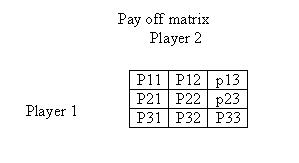X'Pressions
Business and Game-2
This article is a continuation of article published “business and game” in last issue. As for recap we defined game theory as ‘mathematical study of rational behavior where you are in competing with choices which affect both of the players.’ However we can’t be assure about the winning with the help of game theory but we can have a framework of strategic interaction.
As Forbes, July 3, 1995 says “Game theory, long an intellectual pastime came into its own as a business tool.” Standard adoption, audits, pricewar, capacity expansion, external financing, auction are some of the important area of business where we can use it effectively. Before explaining any example we will some key elements of a game like players, strategies (options available for players), payoffs, information and rationality (how do they think). We will redefine again the Nash equilibrium as ‘a set of strategies, one for each player, such that each player’s strategy is a best response to other’s strategies.’
SUV price war game between GM and Ford:
“General motors corp. and Ford Motor Co. slapped larger incentives on popular sport utility vehicles, escalating a discounting war in the light truck category... Ford added a $500 rebate on SUVs, boosting cash discounts to $2500. The Dearborn,Mich., auto maker followed GM, which earlier in the week began offering $2500 rebates on many of its SUVs” Wall Street Journal, Jan 31, 2003.
We can analyze this situation as in last article like prison’s dilemma; the payoff matrix will be like...

This is a payoff table for (Ford, GM). And as we see the dominant strategy for both of players to offer discount but the both firms are worse off when they both discount than if they don’t.
Sometimes in zero sum noncooperative games we follow minimax strategy for player for which payoff matrix has been drawn.

When we select minimum of each row and take the maximum of them then the row from which the element is coming that row will be the strategy for player 1. And it is called maximum value of the game. Similarly for player 2 we choose maximum of each column and then take the minimum of that then this is called minimax pure strategy for player 2. And this is called minimum value of game.
If the minimum value of the game is maximum value of the game then the common value is called saddle point, and the minimax and maximin pure strategy are called optimal minimax strategy.
Further in case where no saddle point occurs we calculate the expected value of game using the probabilities of playing all strategies by both of player. Let Xi be the probability of playing ith row by player 1 and Yj be the probability of playing jth column by player two then expected value of the game will be

Game theory is providing business strategy to follow and optimizing their profits. As Bell says lessons of game theory give us a wider view of our business situation and provide us a more nimble approach to corporate planning. We call this system quite simply the ‘manage the business’ process.
by Achal Kumar Prasad, MBA(IT) 1st Sem, IIITA.